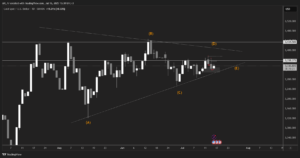Despite an initial dip today, the major indices of the US market have turned positive at this time, gold is moving to reduce its losses and jump back above the important $2300 level, while the dollar maintains its strong rise. The Dow Jones Industrial Average is up 0.11% today, while the Nasdaq is up 0.36% as Nvidia and Apple stocks continue to rise, with strong gains for Rivian and Lucid stocks in the electric vehicle sector. The S&P 500, the most important index, is up marginally by 0.07% to 5473.22 points.
Nvidia’s Rebound Supports Wall Street
The Nasdaq Composite and S&P 500 indices have posted double-digit gains so far this year, thanks to strong gains in the dominant technology sector. Nvidia (NASDAQ: NVDA) shares rose less than 1% at the start of the session, adding to Tuesday’s 7% gains after three days of sharp losses. However, its shares are still up over 150% this year thanks to the huge demand for everything related to artificial intelligence.
Upcoming Economic Data
The key economic data for this week will be released on Friday, with the release of the monthly Personal Consumption Expenditures (PCE) price index. This is the Federal Reserve’s preferred measure of inflation, and with the Fed expecting only one rate cut in December, eyes will be on whether the data will show an expected decline in price pressures.
Company News
- FedEx (NYSE: NYSE:FDX): The company’s shares rose 11% after it forecast annual revenue growth in the low to mid-single-digit range. It also announced a plan to buy back $2.5 billion in stock in its current fiscal year.
- Rivian Automotive (NASDAQ: RIVN): The company’s shares rose more than 30% after entering into a joint venture with Volkswagen (ETR:VOWG_p) (ETR: VOWG), which will see the German automaker initially invest $1 billion in the electric vehicle maker.
- General Mills (NYSE: GIS): The company’s shares fell 6% after it forecast annual earnings below estimates and reported a larger-than-expected decline in quarterly sales due to falling demand for snack bars and pet food, as well as rising input costs.
- Southwest Airlines (NYSE: LUV): The company’s shares fell 4% after it lowered its second-quarter revenue outlook, citing mixed demand for travel.
Oil Prices
Oil prices edged lower on Wednesday, giving up early gains ahead of the release of official US crude inventory figures.
- US crude futures (WTI): Down 0.2% to $80.71 a barrel
- Brent contract: Down 0.1% to $84.10 a barrel
American Petroleum Institute data showed US oil inventories grew by about 0.9 million barrels in the week ended June 21, which was a surprise given expectations of a 3 million-barrel decline, but this is largely being ignored as investors expect inventory draws during the strong demand season in the third quarter.
Oil Demand to Peak and Saudi Arabia Will Control the Price with a New Tool!
Saudi Arabia is not only the world’s largest oil producer, but it also owns the Shoaiba power plant, which is the world’s largest oil-fired power plant, consuming about 200,000 barrels per day at its peak, enough to meet the daily consumption of a small European country like Portugal. Based on this information, Bloomberg published a report on oil prices in which it discusses that Saudi Arabia has the ability to increase the price and consumption of oil, not just its production. Javier Bias, a Bloomberg journalist specializing in commodities and energy, believes that if global oil demand peaks within the next five years, as the International Energy Agency has predicted, it will require more than just widespread adoption of electric vehicles. And Saudi Arabia needs to shift to a lower energy consumption policy to achieve balance, otherwise oil prices will rise sharply. Saudi Arabia consumes about 3.7 million barrels of oil per day, making it the world’s fourth-largest oil consumer after the United States, China and India.
According to the International Energy Agency, Saudi Arabia is expected to see the second-largest decline in oil consumption by the end of the decade, falling by more than 500,000 barrels per day. Saudi Arabia plans to transition to gas-fired and renewable energy power plants in an effort to reduce or eliminate the use of oil for electricity generation by 2030. A key part of this plan is to develop the Jafurah natural gas field, a shale-like gas reserve on Saudi Arabia’s east coast. Bias highlighted four main challenges facing Saudi Arabia to maintain its position as the world’s largest oil producer if demand peaks in the coming years:
- Developing the Jafurah Field: Developing this field is a huge project, and it is unclear whether Aramco (TADAWUL: 2222) can achieve the ambitious timeline.
- Retrofitting Power Plants: Saudi Arabia needs to upgrade some power plants and build new ones to retire old ones.
- Building Renewable Energy Plants: Saudi Arabia needs to build many solar and wind power plants.
- Massive Investments: Saudi Arabia needs to invest billions of dollars in more energy-efficient desalination plants.
If global oil demand is about to peak, Saudi state-owned electricity and water companies will be of great importance alongside electric car companies like Tesla (NASDAQ: TSLA) to achieve a real balance in the market and maintain a balance between global production and consumption.
Oil Prices Now
Brent oil is currently trading at $84.9 a barrel, up 0.5% in the last 24 hours, while US crude is trading at $81.3, up 0.49% today. Saudi Arabia is targeting oil prices to reach $100 to balance the markets, which Western countries consider a catalyst for further inflation. OPEC+, led by Saudi Arabia and Russia, extended oil cuts to the end of 2025, with some countries announcing they would stop cutting at the end of 2025.
The Housing Crisis Escalates in the US: What You Need to Rent a Mid-Range Home!
The Fed chairman said that housing is the most stubborn of all inflation indicators, and home sales data today confirms this fact that Americans have been feeling strongly lately despite the decline in inflation to 3%.Recent data showed that new home sales in the United States fell to their lowest level in six months in May due to rising mortgage rates that affected demand, providing further evidence of a slowdown in the housing market recovery.
New home sales fell 11.3% to a seasonally adjusted annual rate of 619,000 units last month, the lowest since November, the U.S. Commerce Department’s Census Bureau said in its report Wednesday. The sales pace for April was revised up to 698,000 units from 634,000 units previously reported. Economists according to Investing.com data had expected new home sales, which account for more than 10% of U.S. home sales, to come in at 636 units.
Key Indicator and Real Danger
New home sales are a key indicator of the housing market because they are calculated when a contract is signed, however, they can be volatile on a monthly basis. Sales fell 16.5% year-on-year in May. The housing market is struggling as mortgage rates rebound, which has also affected sales of existing homes and homebuilding. Residential investment grew at double-digit rates in the first quarter of the year. The average 30-year fixed mortgage rate hit a six-month high of 7.22% in early May before easing to 7.03% by the end of the month, according to data from Freddie Mac. Sales fell 43.8% in the Northeast and 4.5% in the West. They also fell 12.0% in the densely populated South and 8.6% in the Midwest, which is considered a more expensive region. The median price of a new home fell 0.9% to $417,400 in May compared to a year ago.
Nearly half of the new homes sold last month were priced below $399,000. The Federal Housing Finance Agency reported Tuesday that prices for single-family homes rose 6.3% year-on-year in April. There were 481,000 new homes on the market at the end of May, up from 474,000 units in April, according to the Census Bureau report. At the May sales pace, it would take 9.3 months to clear the supply of homes on the market, up from 8.1 months in April.
Disclaimer: This article is not investment advice or an investment recommendation and should not be considered as such. The information above is not an invitation to trade and it does not guarantee or predict future performance. The investor is solely responsible for the risk of their decisions. The analysis and commentary presented do not include any consideration of your personal investment objectives, financial circumstances, or needs.





